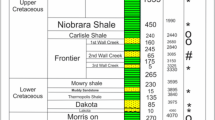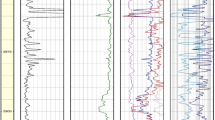Abstract
Rock properties in geomechanical models depend on electrofacies. Electrofacies classification is a crucial task for generating accurate rock property models. Insufficient information about core samples and image logs at all locations is the major drawback in electrofacies classification. This study classified electrofacies by the multi-resolution graph-based clustering (MRGC) approach using the well-log data from the Scotian shelf, Offshore Canada. The unsupervised method such as MRGC, ascendant hierarchical clustering, and self-organizing map uses the K-nearest neighbors and kernel index for defining the cluster dots which characterize the electrofacies. These classified facies are incorporated with core information to establish a relationship. This relation can develop electrofacies in the non-core zone/wells. The electrofacies were predicted using the MRGC approach to generate rock mechanical properties such as Young's modulus, Poisson’s ratio, unconfirmed compressive strength, and internal friction coefficient.











Similar content being viewed by others
References
Ambati, V.; Nagendra Babu, M.; Nair, R.R.: Reservoir wellbore stability analysis and weak zones identification using the 1d MEM, swelling tests and UCS: a case study from Mumbai offshore. India. Arab. J. Sci. Eng. (2021). https://doi.org/10.1007/s13369-021-05530-w
Chang, C.; Zoback, M.D.; Khaksar, A.: Empirical relations between rock strength and physical properties in sedimentary rocks. J. Pet. Sci. Eng. 51, 223–237 (2006). https://doi.org/10.1016/j.petrol.2006.01.003
Inichinbia, S.; Sule, P.O.; Ahmed, A.L.; Hamaza, H.; Lawal, K.M.: Petro physical analysis of among hydrocarbon field fluid and lithofaciesusing well log data. IOSR J. Appl. Geol. Geophys. 2, 86–96 (2014). https://doi.org/10.9790/0990-02218696
Primmer TJ, Cade CA, Evans J, Gluyas JG, Hopkins MS, Oxtoby NH, Smalley PC, Warren EA, Worden RH.: Global patterns in sandstone diagenesis: their application to reservoir quality prediction for petroleum exploration, pp. 61–77 (1997)
Nagendra Babu, M.; Ambati, V.; Nair, R.R.: Characterization of complex fluvial-deltaic deposits in Northeast India using Poisson impedance inversion and non-parametric statistical technique. Sci. Rep. 12, 16917 (2022). https://doi.org/10.1038/s41598-022-21444-5
Riazi, Z.: Application of integrated rock typing and flow units identification methods for an Iranian carbonate reservoir. J. Pet. Sci. Eng. 160, 483–497 (2018). https://doi.org/10.1016/j.petrol.2017.10.025
Ma, Y.Z.: Lithofacies clustering using principal component analysis and neural network: applications to wireline logs. Math. Geosci. 43, 401–419 (2011). https://doi.org/10.1007/s11004-011-9335-8
Doveton, J.H.: Principles of Mathematical Petrophysics. Oxford University Press (2014)
Belozerov, B., Bukhanov, N., Egorov, D., Zakirov, A., Osmonalieva, O., Golitsyna, M., Reshytko, A., Semenikhin, A., Shindin, E., Lipets, V: Automatic well log analysis across priobskoe field using machine learning methods (Russian). In: SPE Russian Petroleum Technology Conference. Society of Petroleum Engineers (2018)
Puskarczyk, E.: Application of multivariate statistical methods and artificial neural network for facies analysis from well logs data: an example of miocene deposits. Energies 13, 1548 (2020). https://doi.org/10.3390/en13071548
Nazeer, A.; Abbasi, S.A.; Solangi, S.H.: Sedimentary facies interpretation of Gamma Ray (GR) log as basic well logs in Central and Lower Indus Basin of Pakistan. Geod. Geodyn. 7, 432–443 (2016). https://doi.org/10.1016/j.geog.2016.06.006
Moradi, M.; Tokhmechi, B.; Kordi, M.; Masoudi, P.: Gamma-clustering sequence stratigraphy, case study of the carbonate Sarvak Formation Southwest Iran. SN Appl. Sci. 1, 1369 (2019). https://doi.org/10.1007/s42452-019-1407-2
Adams, A.; Diamond, L.W.: Facies and depositional environments of the upper Muschelkalk (Schinznach Formation, Middle Triassic) in northern Switzerland. Swiss J. Geosci. 112, 357–381 (2019). https://doi.org/10.1007/s00015-019-00340-7
Inoue, K.; Fukushi, M.; Van Le, T.; Tsuruoka, H.; Kasahara, S.; Nimelan, V.: Distribution of gamma radiation dose rate related with natural radionuclides in all of Vietnam and radiological risk assessment of the built-up environment. Sci. Rep. 10, 12428 (2020). https://doi.org/10.1038/s41598-020-69003-0
Nagendra Babu, M.; Ambati, V.; Nair, R.R.: Lithofacies and fluid prediction of a sandstone reservoir using pre-stack inversion and non-parametric statistical classification: a case study. J. Earth Syst. Sci. 131, 55 (2022). https://doi.org/10.1007/s12040-021-01792-y
Bawazer, W.; Lashin, A.; Kinawy, M.M.: Characterization of a fractured basement reservoir using high-resolution 3D seismic and logging datasets: a case study of the Sab’atayn Basin, Yemen. PLoS ONE 13, e0206079 (2018). https://doi.org/10.1371/journal.pone.0206079
Torres, K.M., Al Hashmi, N.F., Al Hosani, I.A., Al Rawahi, A.S., Parra, H.: Reducing the uncertainty of static reservoir model in a carbonate platform, through the implementation of an integrated workflow: case a-field, Abu Dhabi, UAE. In: Day 1 Mon, November 07, 2016. SPE (2016)
Hossain, T.M.; Watada, J.; Aziz, I.A.; Hermana, M.: Machine learning in electrofacies classification and subsurface lithology interpretation: a rough set theory approach. Appl. Sci. 10, 5940 (2020). https://doi.org/10.3390/app10175940
Wang, G.; Carr, T.R.; Ju, Y.; Li, C.: Identifying organic-rich Marcellus Shale lithofacies by support vector machine classifier in the Appalachian basin. Comput. Geosci. 64, 52–60 (2014). https://doi.org/10.1016/j.cageo.2013.12.002
Qi, L.; Carr, T.R.: Neural network prediction of carbonate lithofacies from well logs, Big Bow and Sand Arroyo Creek fields. Southwest Kansas. Comput. Geosci. 32, 947–964 (2006). https://doi.org/10.1016/j.cageo.2005.10.020
Bhattacharya, S.; Carr, T.R.: Integrated petrofacies characterization and interpretation of depositional environment of the bakken shale in the Williston Basin North America. Petrophysics SPWLA J. Form. Eval. Reserv. Descr. 57, 95–110 (2016)
Maurya, S.P.: Estimating elastic impedance from seismic inversion method: a study from nova scotia field Canada. Curr Sci 116, 628 (2019). https://doi.org/10.18520/cs/v116/i4/628-635
Qayyum, F.; Catuneanu, O.; Bouanga, C.E.: Sequence stratigraphy of a mixed siliciclastic carbonate setting Scotian Shelf Canada. Interpretation 3(2), SN21–SN37 (2015). https://doi.org/10.1190/INT-2014-0129.1
Xiao, M.: Reservoir estimation in the Penobscot 3D seismic volume using Constrained Sparse Spike Inversion, Offshore Nova Scotia, Canada (2016)
Salvaris, M., Kaznady, M., Paunic, V., Karmanov, I., Bhatia, A., Tok, W.H., Chikkerur, S.: DeepSeismic: a deep learning library for seismic interpretation. In: First EAGE Digitalization Conference and Exhibition, pp. 1–5. European Association of Geoscientists & Engineers (2020)
Campbell, T.J.; Richards, F.W.B.; Silva, R.L.; Wach, G.; Eliuk, L.: Interpretation of the Penobscot 3D seismic volume using constrained sparse spike inversion, Sable sub-Basin, offshore Nova Scotia. Mar. Pet. Geol. 68, 73–93 (2015). https://doi.org/10.1016/j.marpetgeo.2015.08.009
Kiaei, H.; Sharghi, Y.; Ilkhchi, A.K.; Naderi, M.: 3D modeling of reservoir electrofacies using integration clustering and geostatistic method in central field of Persian Gulf. J. Pet. Sci. Eng. 135, 152–160 (2015). https://doi.org/10.1016/j.petrol.2015.08.019
Cover, T.; Hart, P.: Nearest neighbor pattern classification. IEEE Trans. Inf. Theory. 13, 21–27 (1967). https://doi.org/10.1109/TIT.1967.1053964
Rahimpour-Bonab, H.; Aliakbardoust, E.: Pore facies analysis: incorporation of rock properties into pore geometry based classes in a Permo-Triassic carbonate reservoir in the Persian Gulf. J. Geophys. Eng. 11, 035008 (2014). https://doi.org/10.1088/1742-2132/11/3/035008
Ye, S.-J., Rabiller, P.: A new tool for electro-facies analysis: multi-resolution graph-based clustering (2000)
Zhang, J.: Kohonen self-organizing map–an artificial neural network. In: Zhang, J. (eds.) Visualization for Information Retrieval. The Information Retrieval Series, vol. 23. Springer, Berlin, Heidelberg (2008). https://doi.org/10.1007/978-3-540-75148-9_5
Kohonen, T.: The self-organizing map. Neurocomputing 21, 1–6 (1998). https://doi.org/10.1016/S0925-2312(98)00030-7
Lotfi Shahreza, M.; Moazzami, D.; Moshiri, B.; Delavar, M.R.: Anomaly detection using a self-organizing map and particle swarm optimization. Sci. Iran. 18, 1460–1468 (2011). https://doi.org/10.1016/j.scient.2011.08.025
Yorek, N.; Ugulu, I.; Aydin, H.: Using self-organizing neural network map combined with ward’s clustering algorithm for visualization of students’ cognitive structural models about aliveness concept. Comput. Intell. Neurosci. 2016, 1–14 (2016). https://doi.org/10.1155/2016/2476256
Szymański, J.: Self–organizing map representation for clustering wikipedia search results. In: Intelligent Information and Database Systems—Third International Conference, pp. 140–149 (2011)
Campoy, P.: Dimensionality reduction by self organizing maps that preserve distances in output space. In: 2009 International Joint Conference on Neural Networks, pp. 432–438. IEEE (2009)
Natita, W.; Wiboonsak, W.; Dusadee, S.: Appropriate learning rate and neighborhood function of self-organizing map (SOM) for specific humidity pattern classification over Southern Thailand. Int. J. Model. Optim. 6, 61–65 (2016). https://doi.org/10.7763/ijmo.2016.v6.504
Arnault, S.; Thiria, S.; Crépon, M.; Kaly, F.: A tropical Atlantic dynamics analysis by combining machine learning and satellite data. Adv. Sp. Res. 68, 467–486 (2021). https://doi.org/10.1016/j.asr.2020.09.044
Ward, J.H.: Hierarchical grouping to optimize an objective function. J. Am. Stat. Assoc. 58, 236–244 (1963). https://doi.org/10.1080/01621459.1963.10500845
Lukasová, A.: Hierarchical agglomerative clustering procedure. Pattern Recognit. 11, 365–381 (1979). https://doi.org/10.1016/0031-3203(79)90049-9
On the geology of Nova Scotia. Nature 3, 214–215 (1871). https://doi.org/10.1038/003214a0
Gould, K.M.; Piper, D.J.; Pe-Piper, G.: Lateral variation in sandstone lithofacies from conventional core Scotian Basin: implications for reservoir quality and connectivity. Can. J. Earth Sci. 49(12), 1478–1503 (2012). https://doi.org/10.1139/e2012-064
Acknowledgements
The authors would like to thank OpendTect for providing the data in the Penobscot 3D field. We would also like to thank Emerson-Paradigm for providing an academic license to carry out research work.
Author information
Authors and Affiliations
Contributions
PM: Conceptualization, methodology, investigation, interpretation of results, writing and editing manuscript. KHS: Supervision and Validation of results. Both authors comprehended and designed the workflows and wrote the paper.
Corresponding author
Ethics declarations
Conflicts of Interest
The authors do not have any conflict of interest.
Rights and permissions
Springer Nature or its licensor (e.g. a society or other partner) holds exclusive rights to this article under a publishing agreement with the author(s) or other rightsholder(s); author self-archiving of the accepted manuscript version of this article is solely governed by the terms of such publishing agreement and applicable law.
About this article
Cite this article
Mahadasu, P., Singh, K.H. Electrofacies Estimation of Carbonate Reservoir in the Scotian Offshore Basin, Canada Using the Multi-resolution Graph-Based Clustering (MRGC) to Develop the Rock Property Models. Arab J Sci Eng 48, 7855–7866 (2023). https://doi.org/10.1007/s13369-022-07521-x
Received:
Accepted:
Published:
Issue Date:
DOI: https://doi.org/10.1007/s13369-022-07521-x




